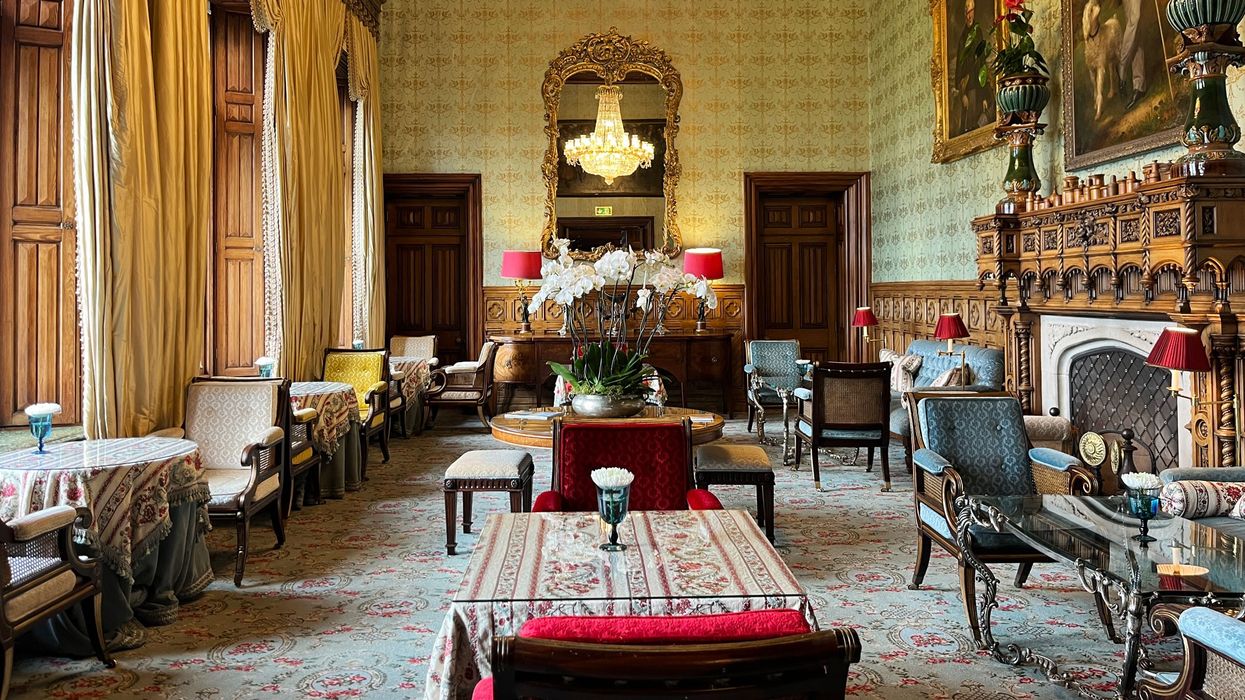
“Well, aren’t you living the life of Riley,” a stately Irishman named Dennis says with a grin. It’s my last night in Dromoland Castle, a historic estate-turned-hotel planted on the wild landscapes of Ireland’s County Clare, and I am on my fifth course at the hotel’s Earl of Thomond restaurant (the dish in question is the roast breast of Thorn Hill duck). Venturing alone into Ireland’s hidden heartlands in the dregs of winter may sound like a recipe for melancholic disaster, but as so many ‘off-season’ trips have taught me, any time is a good time.
And this was no pedestrian holiday. My nine-day adventure to the Emerald Isle was guided by Brendan Vacations, a tour operator in both Ireland and Scotland with over 50 years of know-how. Though I don’t typically work with travel planning services for trips, their castle tour changed my mind. Private chauffeur! Regal accommodations! Authentic Celtic expeditions! It was everything I wanted out of my moody-weather getaway. Not having to research and puzzle together a complex itinerary of flights, reservations, experiences, and driving routes freed up mental space to savor each moment.
My trip begins and ends in Dublin, just a six-hour flight from New York City. “This is a city of writers,” my driver Hugh tells me en route to The Merrion Hotel—a fact I’m well aware of. Attempting to write anything meaningful about Ireland in the shadow of literary giants like Joyce, Yeats, Beckett, Wilde, Swift, Shaw, and so many others is nothing short of humbling. But as I’m reminded many times on this journey, Ireland is an evolving country—forever changed by famine and steadily pushing forward since. In other words, there will always be a new story to tell.
The next day, I meet my private chauffeur, Andy, a kind-hearted retired cop with a strong sense of Irish sarcasm and an even stronger fidelity to Irish rugby. He was the perfect no-nonsense companion for someone like me who might otherwise eschew a traditional tour format. And so we set off into the verdant countryside, stopping at cozy pubs, rugged national parks, centuries-old castles, and steep seaside cliffs.
Historic Castles
A series of towering stone turrets guards the entrance to Ashford Castle, the same pathway George V entered the grounds through on his visit in 1905 (which, in fact, was constructed for just the occasion). I love this kind of stuff: historical tidbits that drag you back in time. I hopped right into a private tour of the grounds with Fintan, a local historian who I later learned is also a retired principal. He tells me that Ashford is composed of three main parts: a military fortification dating back to the 12th century, a chateau-style estate from the early 1700s, and construction from the 1970s—all sandwiched together to create what is now one of the most picturesque castle hotels in the entire country. Between the original wood ceiling from the 1700s, the cocktail lounge with its crackling fireplace, and my upholstered four-poster bed, it’s about the closest I’ve come to feeling like royalty.
Three days later, Dromoland Castle is the second stop on my tour de countryside estates. I’m equipped with local historian Jane, who tells me it was originally a family home that belonged to the O’Briens, descendants of the King of Ireland, Brian Boru (casual). The oldest part of the castle still standing is The Queen Anne Court, where I peacefully sleep for the next three nights. The best feature of this elegant home-turned-hotel is the drawing room, where I enjoy a glass of Champagne and a few chapters of my book each evening before drifting over to dinner at the Earl of Thomond restaurant and then back to the main gallery for live Irish folk music and a nightcap next to the fireplace.
Cinematic Landscapes
I would be fibbing if I said The Banshees of Inisherin didn’t play a role in my motivation to visit Ireland; I’m still drooling over that rustic pub by the sea. When customizing my itinerary with Brendan Vacations, I knew I needed to check ‘arresting landscapes’ off my list, beginning with Connemara. This national park in the west of Ireland is known for its traditional Irish heritage. (Andy tells me his daughter comes here in the summers to learn the Irish language.) There’s also the Connemara Pony, indigenous to the region, and the country’s only fjord, Killary Harbour. This is where the scenery begins to look extremely Irish—winding along misty roads next to rolling green hillsides threaded by slim streams of fresh mountain water—it’s boastfully picturesque. I ask Andy to be on the lookout for a pitstop where I can photograph all of these things in one composite. “Sure, maybe I can get a salmon to jump out of the stream in front of the fjord for you, too.” (Did I mention I love Andy’s sarcasm?)
Next, he drops me off at the Cliffs of Moher with specific instructions: “If you’re feeling more adventurous, go left.” This world-famous walk overlooking the wild Atlantic Ocean is staggering; these unique cliffs reach over 700 feet at their highest point and wrap the coastline for five miles as the crow flies. The route to the left leads me along a muddy path with spectacular vistas of the cliffs that plummet downward onto crashing waves (a location that was, fun fact, used as a filming location for Harry Potter).
Then there’s Burren National Park. An ancient limestone seabed formed 350 million years ago, and is now a special conservation area spanning 1,800 hectares. Here, I meet up with Marie—the ‘Wild Burren Woman,’ as she calls herself. Marie grew up in the area, so I’m granted access to a private part of the landscape she calls the Hidden Burren. “I want to show you my fossils,” she says excitedly, hopping over cracks between the rocks to retrieve a large slab of stone, revealing what looks like the remnants of clam shells. “I make a lot of decisions about my life here in the Burren,” Marie tells me. During the warmer months of the year, colorful wildflowers spring up between the crevices of the silvery limestone, creating an impossibly magical display of nature. I am admittedly remorseful I don’t get to witness the blooms, but Marie fixes this. “Woo-hooooooo,” she yells as we hop over a fence to run up the hill and take in the majestic Burren from a bird’s eye view. “I’ll leave you to it,” she says thoughtfully after a couple of minutes, allowing me to soak everything in. As I said, any time is a good time.
Animal Encounters
Though falconry is among the more popular animal experiences that travelers seek out when visiting Ireland (some accounts report its history in the country can be traced as far back as 2,000 BC), my preferences lean toward that of the equine variety. I catch up with Mary at Ashford Castle’s equestrian center, and she selects a Connemara Pony named Bean for me to ride around the grounds. We clip-clop into the forest beside lush green moss and trees beside sparkling waterfalls and babbling brooks. “This isn’t even that green,” Mary says with a knowing grin, adding that the next few months will render the landscape even brighter.
The following morning, I meander from Ashford Castle’s entrance to the nearby forest to take a leisurely stroll with a pack of Irish Wolfhounds. If you’re unfamiliar, this noble breed is the world’s tallest dog and fought alongside the Celts during the Gallic Wars. Their handler, James, reminds me of Hagrid—exceptionally tall with a bellowing voice and a gaggle of animals that could probably kill me if they wanted to. Thankfully, they don’t—Mulligan, Finnegan, Shea, Molly, and the ‘flip flop’ dog (a black Labrador that carries a flip flop in his mouth the entire time) enthusiastically guide us through the woods. Guests of the hotel can partake in this outing every morning and borrow a pair of Wellies from the front desk for clomping around in the mud—very Irish.
Irish Fare
A slice of soda bread, a pour of Guinness, and a plate of meat and potatoes are still standard fare in Ireland, but as I learned on food tours in Dublin and Galway, there’s so much more to experience. I catch up with my guide, Eveleen Coyle of Fab Food Trails, at the entrance of Sheridans in Dublin, a cheesemonger that’s been around since the ‘90s and part of the broader push to evolve the cheese scene in the country. “One of the things about cheese in Ireland is that because it’s so new, a lot of education needs to be done to steer people away from misconceptions,” the shop attendant tells us as we sample a delicious goat’s milk cheese with fenugreek and coriander. He cites producers like Milleens, founded in the 1970s, as playing a defining role in the revival of farmhouse cheesemaking in Ireland.
About a two-hour drive west in Galway, I join Regina from Galway Food Tours at Ean to sample their selection of natural wines paired with innovative dishes like squid toast and cabbage fritters. The restaurant (at the helm of Enda McEvoy and Sinead Meacle) also has an in-house bakery, which Regina tells me makes a killer sourdough thanks to the native yeast on the bakery’s stone walls. We also sample more traditional bites at Tigh Neachtain—a traditional Irish pub with charming ‘snugs’ (an intimate seating nook) where you can enjoy lamb meatballs in a homemade tomato sauce or muscles from Connemara washed down with a local craft beer. It’s the oldest pub in the city and one of the most charming I’ve ever stepped inside.
I spend my last day in Ireland in Dublin—devouring scones and sweets at The Shelbourne’s iconic afternoon tea service (for one!) and relishing my final moments at The Merrion Hotel, a luxury hotel set in four restored Georgian townhouses with decor that lights my Regency-era-loving-heart ablaze. It would be all too easy to stay put in my five-star room, which overlooks striking Edwardian buildings, but I realize with a pang of panic that I haven’t tried a drop of whiskey since landing on Irish soil. I swiftly resolve the issue with a visit to The Merrion’s cocktail bar, where I enjoy a pour of Powers John’s Lane beside the fireplace. A fitting ending to my very Irish journey.




